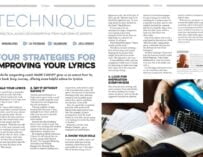Though it may seem to defy musical logic, chorus rhythms are usually longer than verse rhythms. Gary Ewer explains why…

When you think about instrumental accompaniment, you’ll likely find more rhythmic activity in the chorus. But the words themselves start to spread out a bit, using longer time values.
A good case in point is Taylor Swift’s hit, We Are Never Ever Getting Back Together…
The verse lyric is quick and light, with lots of 16th-notes (i.e., 4 notes per beat). But the chorus lyric changes, using longer notes with only occasional short quick ones.
You don’t need to be able to read musical notation to grasp this. Just compare this:
VERSE:
I remember when we broke up the first time
Saying this is it, I’ve had enough, ’cause like
We haven’t seen each other in a month
When you, said you, needed space, what?[cc_blockquote_right] LONGER WORDS HELP EXTRACT EMOTIONAL VALUE, GIVING THE TEXT MORE TIME TO WORK ON THE LISTENER [/cc_blockquote_right]
…to this:
CHORUS
We are never ever ever getting back together
We are never ever ever getting back together
You go talk to your friends talk
To my friends talk to me…
The difference isn’t exactly dramatic, but you wouldn’t expect a dramatic difference anyway when you’re talking about the verse and chorus of the same song. But you can definitely hear the elongated rhythms suddenly occur in the chorus. The question, though, is why?
The rhythm of the lyric plays a large role in how a listener perceives the emotional content. Longer words help extract emotional value, giving the text more time to work on the listener.
Many songs do this. Even if verse and chorus rhythms tend to be largely the same, you’ll still hear that the chorus is the likely place to insert long rhythms in amongst the quicker ones, so the differences can be subtle. Compare the rhythm of the verse lyric to the chorus in these songs:
Woman (John Lennon)
Papa Don’t Preach (Brian Elliot/Madonna)
Adia (Sarah McLachlan/Pierre Marchand)
Stronger (What Doesn’t Kill You) (Jörgen Elofsson, Ali Tamposi, David Gamson, and Greg Kurstin, sung by Kelly Clarkson)
You’ll notice that this rhythmic difference between verse and chorus doesn’t always happen, and that shouldn’t surprise us. Songwriters have lots of tools at their disposal for allowing for higher emotions other than the rhythm of the words. Foreigner’s I Want to Know What Love Is is a good example of a verse and chorus that use fairly similar rhythms between the two sections.
But elongated chorus rhythm happens more often than you might realise. If you’re trying to figure out why your chorus just isn’t getting the emotional response you’re hoping for, take a look and see if your chorus rhythms might need some adjusting.
 Gary Ewer has until recently been a full-time music instructor at Dalhousie University in Canada, teaching ear training, music theory, choral techniques, and conducting two university choral ensembles. He now works full-time for his music publishing company, Pantomime Music Publications. To learn more visit The Essential Secrets Of Songwriting where Gary has several songwriting e-books available. He is also the author of Gary Ewer’s Easy Music Theory, a CD-ROM-based course in music rudiments, and you can read more about that here.
Gary Ewer has until recently been a full-time music instructor at Dalhousie University in Canada, teaching ear training, music theory, choral techniques, and conducting two university choral ensembles. He now works full-time for his music publishing company, Pantomime Music Publications. To learn more visit The Essential Secrets Of Songwriting where Gary has several songwriting e-books available. He is also the author of Gary Ewer’s Easy Music Theory, a CD-ROM-based course in music rudiments, and you can read more about that here.


































Related Articles